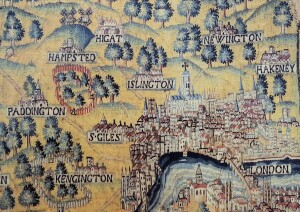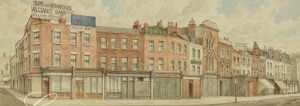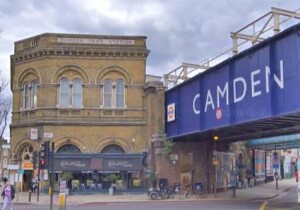Camden Town is a part of inner London. It was on land owned by Lord Camden. This web site is a Museum of materials and Stories from the history.
The land that became Camden Town was once fields outside London, between St Giles and the hills of Hampstead and Highgate to the north
 The Thames basin was created around 450,000 years ago. The river’s tributaries, including the River Fleet, cut through the land. In the 1840s, men digging sewers in Camden Road found fossils – identified as mammoth and hippopotamus tusks – from the Paleolithic period of 100,000 years ago. These are now in the Natural History Museum.
The Thames basin was created around 450,000 years ago. The river’s tributaries, including the River Fleet, cut through the land. In the 1840s, men digging sewers in Camden Road found fossils – identified as mammoth and hippopotamus tusks – from the Paleolithic period of 100,000 years ago. These are now in the Natural History Museum.
Lands in the Parish of St Pancras were recorded in the 1086 Domesday Survey. The Cantlowes manor and farm, of about 210 acres, were described in the Parliamentary survey of 1649 as belonging to St Paul’s Cathedral, and its lease could be traded by one of the clergy.
The lease was bought by a physician,  Sir George Ent, in 1667. In 1682 he sold it to John Jeffreys, a City merchant who imported tobacco from north America.
Sir George Ent, in 1667. In 1682 he sold it to John Jeffreys, a City merchant who imported tobacco from north America.
Over three generations, the lease passed to Elizabeth Jeffreys, who married Charles Pratt, future Lord Camden. Camden Town did not start as a traditional English village centred on a green, such as Hampstead and Highgate. Nor was it a strip development along a main road, such as Kentish Town and Islington. It was, in the words of architectural historian of London, John Summerson, a ‘Georgian suburb’, newly created on fields either side of the River Fleet through permission of an Act of Parliament in 1788.
Camden Town did not start as a traditional English village centred on a green, such as Hampstead and Highgate. Nor was it a strip development along a main road, such as Kentish Town and Islington. It was, in the words of architectural historian of London, John Summerson, a ‘Georgian suburb’, newly created on fields either side of the River Fleet through permission of an Act of Parliament in 1788.
 The Roque map of 1746 shows the Fleet, roads and fields. The road from Tottenham Court to Hampstead passes to the northwest. It divides at the Mother Red Cap inn and crosses the Fleet. Kentish Town is a straggle of houses along the road. Here, the inn and workhouse are identified as red, the River Fleet in blue and the Cantlowes demesne land is outlined in orange.
The Roque map of 1746 shows the Fleet, roads and fields. The road from Tottenham Court to Hampstead passes to the northwest. It divides at the Mother Red Cap inn and crosses the Fleet. Kentish Town is a straggle of houses along the road. Here, the inn and workhouse are identified as red, the River Fleet in blue and the Cantlowes demesne land is outlined in orange.
William Blake wrote and engraved these words in Chapter 2 of his poem Milton (1804):

Camdens
The name ‘Camden’ originated with William Camden, notable historian of Britannia in the Elizabethan period. Charles Pratt bought the house that William had built near Chislehurst, Kent. Charles was a successful lawyer and politician, becoming Lord Chancellor and in 1788 Earl Camden. His son, John Jeffreys Pratt, married Frances Molesworth in 1785, becoming Viscount Bayham and then second Earl in 1794

John Jeffreys was made Marquis Camden in 1812. His only son, George, who was first titled Lord Brecknock, in 1835 married Harriet Murray. He was succeeded by his son John, the fourth earl, in 1866, who died at the young age of 32 in 1872. (The names of the family were used widely for the roads in Camden Town.)
Building
The estate development was managed by agents – from 1780 to 1803 by Augustine Greenland, a solicitor; from 1804-1822 by the Mayfair agents Kent, Claridge and Iveson; from 1823 by Joseph Kay, architect and estate manager of Gower Street; and from 1847 by John Shaw, also an architect and estate manager.
1800s. The first houses were built along what is now Camden High Street and the Veterinary College was established by old St Pancras church.
 The Regent’s Canal was dug from 1815 and opened in 1820 with four road bridges. There was a cemetery for St Martins-in-the-Fields parish and a new Chapel in classical style.
The Regent’s Canal was dug from 1815 and opened in 1820 with four road bridges. There was a cemetery for St Martins-in-the-Fields parish and a new Chapel in classical style.
Camden Road, from 1825, provided a new axis northwards. New building was along King’s Road (now St Pancras Way), as Jeffreys Street near Kentish Town and Randolph Street at the former manor house.
 In the 1840s, building was along Camden Road and starting on squares either side. The North London Railway was built across Camden Gardens.
In the 1840s, building was along Camden Road and starting on squares either side. The North London Railway was built across Camden Gardens. 
Development continued in 1850s along a third axis of St Paul’s Road (now Agar Grove), up to Maiden Lane (now York Way). The northern streets were completed by 1870, and the North London Railway was widened with Camden Town rail station rebuilt.
Seventy builders took contracts for land to build houses, as villas and terraces, and there were individual leases also. Some of the builders then lived in Camden Town in their own houses and took on positions in local society.
Living
There are memories of recreation and entertainment in the fields- balloons, races, tea gardens. There was Devonshire wrestling and occasional duels. And Camden Town had a cricket team.
Schools included private homes, a Ragged school, National Board Schools and Collegiate schools. The leadership of Frances Buss for girl’s education has gained national recognition.
included private homes, a Ragged school, National Board Schools and Collegiate schools. The leadership of Frances Buss for girl’s education has gained national recognition.
For adult learning, Camden Town had day and evening institutes and for a short while, a Literary and Scientific Institute led by James de Carle Sowerby. The Veterinary College in College Street and (from 1907) the Working Men’s College in Crowndale Road were also important local educational institutions.
The parish church of St Pancras, rebuilt in the nineteenth century, served Somers Town. Four large Church of England churches were built, as well as Methodist, Baptist and Presbyterian chapels – and briefly a synagogue in York Way. There was a Salvation Army hall in Rochester Road and a Spiritualist hall (Conan Doyle laid the foundation stone) in Rochester Square.
The land was first cultivated as hay for feed and then dug as bricks for building. As well as skilled trades, such as engraving and making musical instruments, there was employment at the canal wharves and the railways and in factories for printing. Some of the larger businesses were household names.

Camden Town’s artisan and professional classes have been born in Camden Town as well as coming to live there – there are records of engravers and photographers, scientists and writers, musicians and artists.
Mid-nineteenth century writing presented Camden Town as modest and respectable, a place of refuge perhaps or temporary lodgings, while music hall songs suggested romance.
Charles Booth’s survey of 1891 shows Camden Town relatively advantaged compared with surrounding Somers Town and Kentish Town. Although model housing was started at Battle Bridge (St Pancras), the only rehousing projects at the time within Camden Town itself were at the very edges – Goldington House by St Pancras Vestry and at Clarence Road (Durdan’s House) by Kentish Town.
Explore the Museum and Stories for more detail
And celebrate Conservation for Camden Town


